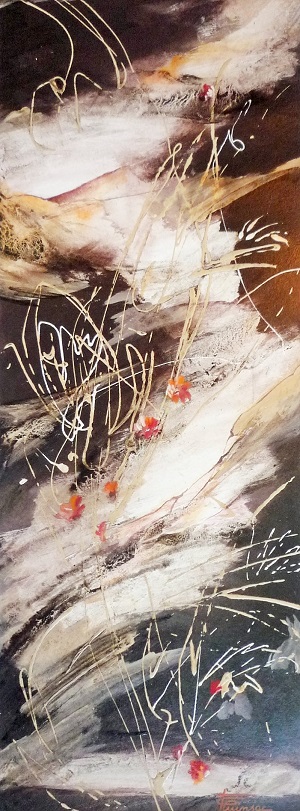|
|
Fabienne Quinsac looking at the Loire River, in front of her house in Saint-Ay, a small town near Orléans (France)
The curiosity cabinet
Fabienne Quinsac took her work very seriously, but not herself. She always preferred to exhibit her paintings in small places with friends rather than alone in a gallery. She would even give paintings to people that came to exhibitions or art fairs and liked her work but had no money to buy art. Fabienne could explore the greatest depths of her mind and intimacy, but also liked to play with her need to create. In fact, she considered there was no way to create but in permanent experimentation. Once she had created a particularly accomplished work, rather than repeating it over and over to sell more, she usually changed her style all of a sudden and started to experiment again. Colors, materials and shapes paved the road of her pictorial adventures. This is how she gave birth to unsightly characters looking like elves of fairy tales in watercolor paintings for her grandchildren; or miniatures painted on pebbles found on the banks of the Loire River; or sculptures made half from wood, half from flotsam and jetsam (see here - beware: this page is in French); or unexpected paintings emerging in a homogeneous series.
Danse
macabre (Dance of Death)
Fuite à Varennes (Flight to Varennes) 116x81 cm acrylc on carboard 1400€ The Flight to Varennes is a famous episode in the French history that takes place in 1791, two years after the French Revolution: king Louis XVI and queen Marie Antoinette try to flee the country to organize a counter-revolution from outside, but they are recognized and arrested.
Eole (Aeolus) Try to find where Aeolus is hiding in this painting!
untitled
Gravitation This is a peculiar work: Fabienne signed it in the upper left corner and in the down right corner. Click here to watch it in both ways at the same time.
untitled White and grey shades: this must be a painting from late 2012 or from 2013, the year when Fabienne Quinsac passed away. She had been going through difficult times, and her very last series, the Monochromes, were really barren as the artist was recklessly confronting herself. Still, she found the resources to play with her art. Perhaps it was her way to take a deep breath before diving again in personal exploration.
Paperasses (Red Tape)
untitled diptych 86x62 cm mixed technique (tar and acrylic) 900€
untitled 29x48 cm mixed technique 350€ This unsigned and untitled painting might give an example of what Fabienne herself would often do after she started to work on a new painting: turn it upside dow or on one side to find further inspiration or see what she had not seen while painting. Well, you can play the same game: either click on the painting to enlarge it, or click here and chose the way you like it most!
Venise
Cluasme Fabienne wrote "Métamorphose cluasmatique" on the down left corner as a kind of title. But the word "cluasmatique" doesn't exist in French. Maybe she meant "chleuasme", a rhetorical figure that resort to false modesty to get praised by other people.
The very beginning
L'église de Sainte-Agnès 30x40 cm end of the 1960's Fabienne especially liked this ancient and medieval village (the highest coastal village in Europe) where her parents had bought a tiny house in the 1950's. At an altitude of more than 700 m, it is only 2,5 km away from the Mediterranean Sea, and a valley away from the border with Italy. This is where Fabienne got married in 1969 and where she often went on holidays with her two kids in the 1970's. Later on, Fabienne still kept going back to Sainte-Agnès in spring to find serenity and to paint and walk in the mountain. Two artists and friends of her still live there : master glass maker Frédéric Pélissier and abstract painter Mauricette Berton.
Vue du village
de Sainte-Agnès depuis la route de Peille 40x40 cm end of the 1960's
Collage
with wallpaper
Fabienne
Quinsac (second from the left),
Study in perspective (1960s)
|
|||||||||||||



































